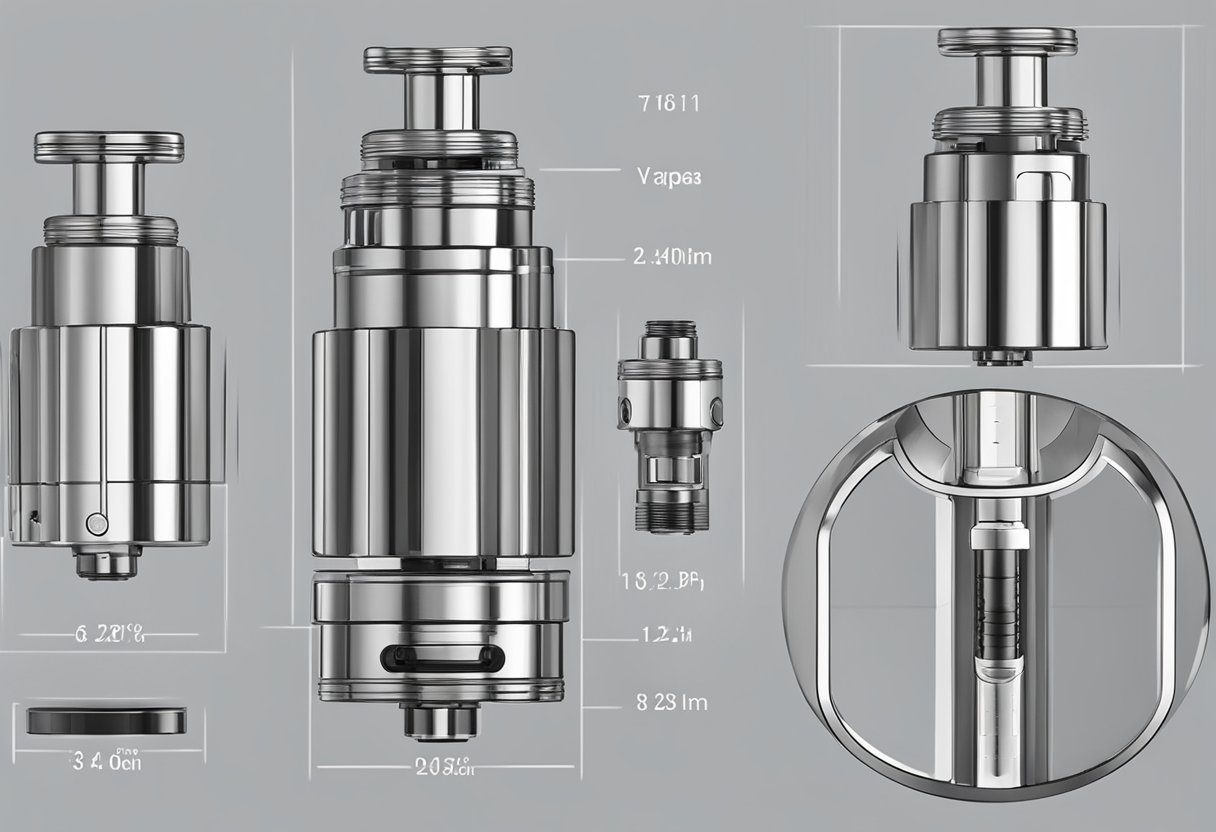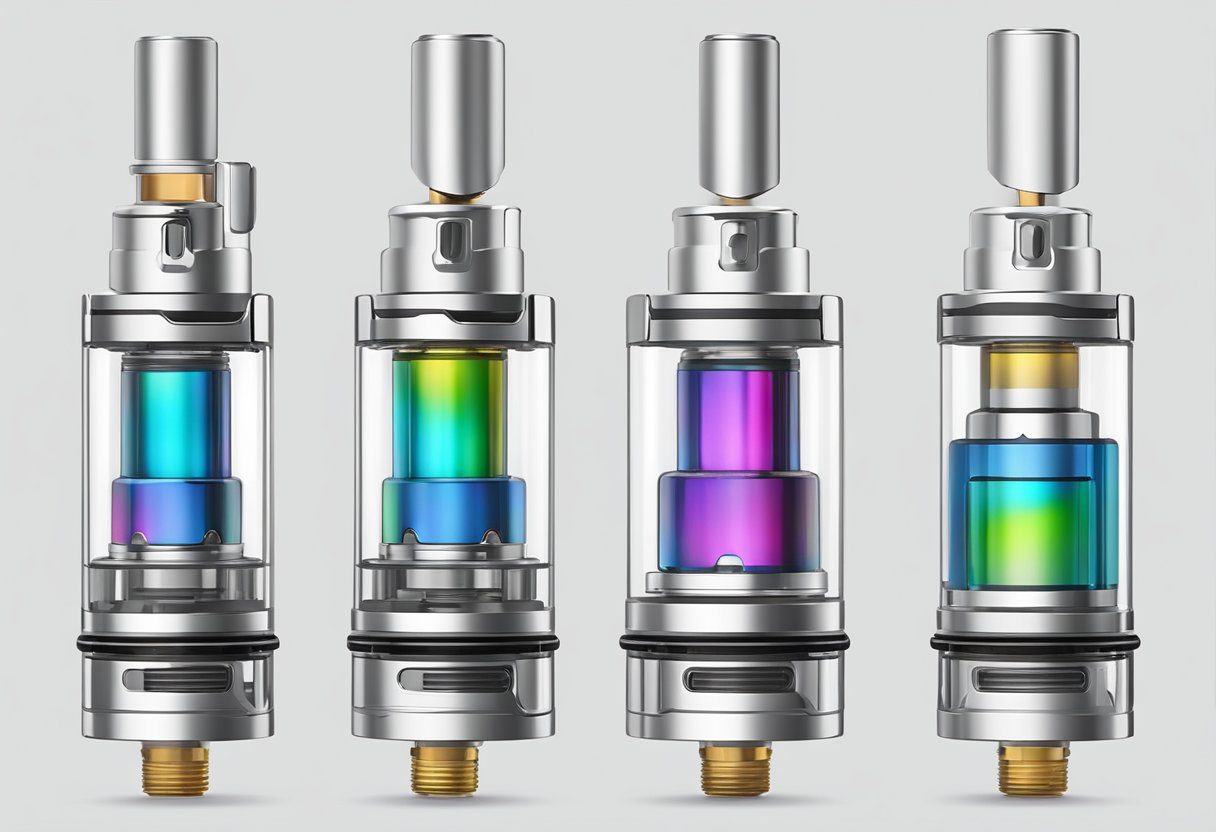Vape Tank Airflow Control: Everything You Need to Know
Vape Tank Airflow Control is an essential aspect of vaping that can significantly impact the overall experience. It refers to the amount of air that flows over the coil as you inhale, affecting the vapour temperature, density, and flavour. Vape tanks come with adjustable airflow control mechanisms that allow you to regulate the amount of air that flows through the device.
Understanding the role of airflow in vaping is crucial for anyone who wants to enjoy a satisfying vaping experience. The amount of air that enters the device can affect the amount of vapour produced, the flavour, and the throat hit. In addition, the type of coil and e-liquid used can also influence the airflow and the overall vaping experience.
Components influencing airflow include the size and position of the air holes, the type of coil, and the design of the device. Manufacturers provide user manuals that explain how to adjust the airflow control to achieve the desired vaping experience. Frequently asked questions about airflow control include how to adjust the airflow, what is the best airflow setting, and how to clean the device.
Contents
- 1 Vape Tank Airflow Control: An Overview
- 2 Understanding the Role of Airflow in Vaping
- 3 Components Influencing Airflow
- 4 Effect of Airflow on E-Liquids and Coils
- 5 Manufacturers and User Manuals
- 6 Frequently Asked Questions:
- 6.1 How do I adjust the airflow on my vape tank?
- 6.2 What are the benefits of adjustable airflow on a vape?
- 6.3 Is it better to have high or low airflow on a vape tank?
- 6.4 What is the ideal airflow setting for flavourful vaping?
- 6.5 Can the airflow on a vape tank affect the amount of vapour produced?
- 6.6 Are there any safety concerns when adjusting the airflow on a vape tank?
Key Takeaways
- Vape Tank Airflow Control is an essential aspect of vaping that can significantly impact the overall experience.
- Understanding the role of airflow in vaping is crucial for anyone who wants to enjoy a satisfying vaping experience.
- Components influencing airflow include the size and position of the air holes, the type of coil, and the design of the device.
Vape Tank Airflow Control: An Overview
Vape tank airflow control is an essential feature that allows vapers to adjust the amount of air that flows over the coil as they inhale. This adjustment affects the vapour temperature, density, and overall vaping experience. The airflow control mechanism is usually located at the base of the tank and can be adjusted by turning an airflow collar or AFC ring.
There are two types of airflow settings available on vape tanks: restricted airflow and higher airflow. Restricted airflow is suitable for mouth-to-lung (MTL) vaping, where the vapour is drawn into the mouth before inhaling into the lungs. Higher airflow is suitable for direct-to-lung (DTL) vaping, where the vapour is inhaled directly into the lungs.
Many vape tanks come with adjustable airflow control mechanisms that allow vapers to regulate the amount of air that flows over the coil. Adjusting the airflow affects the vapour temperature, density, and overall vaping experience. In broad terms, here is how airflow affects vaping:
- More airflow results in cooler vapour and a less dense vapour cloud.
- Less airflow results in warmer vapour and a denser vapour cloud.
Vape tanks with an easy-to-use airflow control ring, seamless top filling, and a leak-proof top airflow system are becoming increasingly popular among vapers. These tanks offer a more customisable vaping experience and are suitable for both MTL and DTL vaping styles.
In conclusion, vape tank airflow control is a critical feature that allows vapers to tailor their vaping experience to their personal preferences. Whether you prefer MTL or DTL vaping, adjusting your airflow settings can significantly enhance your vaping experience.
Understanding the Role of Airflow in Vaping
Airflow control is a vital aspect of vaping that can transform the user’s experience. It determines the amount of air that flows through the vape tank during inhalation and affects the flavour, throat hit, and vapour production.
When the airflow is restricted, the user experiences a tighter draw, resulting in a more concentrated flavour and a harsher throat hit. This setup is ideal for mouth-to-lung (MTL) vaping, where the user inhales the vapour into their mouth before drawing it into their lungs. MTL vaping requires a tighter draw, which is achieved by restricting the airflow.
On the other hand, when the airflow is more open, the user experiences a looser draw, resulting in a cooler vape with less flavour concentration and a smoother throat hit. This setup is ideal for direct-to-lung (DTL) vaping, where the user inhales the vapour directly into their lungs. DTL vaping requires a looser draw, which is achieved by opening up the airflow.
Adjusting the airflow also affects the amount of vapour produced. A tighter draw results in less vapour, while a looser draw results in more vapour. This is why some vapers prefer to chase clouds and adjust their airflow accordingly for maximum cloud production.
Furthermore, airflow control affects the nicotine delivery and flavour intensity. A tighter draw results in a higher concentration of nicotine and flavour, while a looser draw results in a lower concentration. This is why some vapers prefer a tighter draw for a stronger nicotine hit and more intense flavour.
In conclusion, airflow control is a crucial element of vaping that can significantly impact the user’s experience. By adjusting the airflow, vapers can fine-tune their setup to achieve the desired flavour, throat hit, vapour production, and nicotine delivery.
Components Influencing Airflow
The airflow in a vape tank is influenced by several components. These components include:
Coil
The coil is an essential component that plays a crucial role in determining the amount of airflow in a vape tank. The type of coil used significantly affects the amount of air that flows through the tank. A sub-ohm coil, for instance, allows for more airflow than a regular coil. This is because sub-ohm coils have a lower resistance, which allows for more current to flow through them.
Tank
The tank is another component that influences the amount of airflow in a vape tank. Tanks that come with adjustable airflow control mechanisms allow users to regulate the amount of air that flows over the coil as they inhale. This, in turn, affects the intensity of the flavour, draw resistance, and vapour production.
Devices
The device used also has a significant impact on the amount of airflow in a vape tank. Box mods, for instance, come with a range of features that allow users to adjust the airflow to their liking. Pod mods, on the other hand, have a fixed airflow, which limits the user’s ability to adjust the airflow.
Rebuildable
Rebuildable tanks and atomisers allow users to customise their vaping experience by building their own coils and adjusting the airflow. AFC rings, under-coil inserts, and juice wells are some of the features that allow users to adjust the airflow in rebuildable tanks.
Mouthpiece
The mouthpiece or drip tip is another component that affects the amount of airflow in a vape tank. Wide-bore drip tips allow for more airflow, which results in a cooler vape with more vapour production. Narrow-bore drip tips, on the other hand, restrict the airflow, resulting in a warmer vape with less vapour production.
Wicking
The wicking material used in a vape tank also affects the amount of airflow. A tight wick restricts the airflow, resulting in a warmer vape with less vapour production. A loose wick, on the other hand, allows for more airflow, resulting in a cooler vape with more vapour production.
In conclusion, several components influence the amount of airflow in a vape tank. Users can adjust the airflow to their liking by selecting the right components and adjusting the settings on their devices.
Effect of Airflow on E-Liquids and Coils
Airflow control is an important aspect of vaping, as it can significantly affect the quality of the vaping experience. One of the most significant impacts of airflow control is on the e-liquid and coil.
When the airflow is restricted, the volume of vapour being produced is decreased, resulting in a warmer and tighter draw. This can lead to a more intense flavour, but also a harsher throat hit. On the other hand, with increased airflow, the vapour production is greater, and the cloud is cooler, resulting in a slightly lower flavour and less chance of a harsh throat hit.
The airflow control also affects the coil life. When the airflow is restricted, the coil is exposed to higher temperatures, which can lead to a shorter lifespan. Conversely, with increased airflow, the coil is exposed to lower temperatures, which can prolong its lifespan.
It is also essential to note that the wattages used in vaping can affect the e-liquid and coil. Higher wattages can result in a warmer and denser vapour, which can lead to a more intense flavour. However, this can also lead to a shorter coil lifespan and a harsher throat hit. Lower wattages, on the other hand, can result in a cooler and less dense vapour, which can lead to a more subtle flavour and a smoother vaping experience.
In conclusion, the airflow control is a crucial factor in vaping, affecting the e-liquid, coil life, and wattages used. It is essential to find the right balance between airflow, wattage, and e-liquid to achieve the desired vaping experience.
Manufacturers and User Manuals
Vape tank manufacturers often provide user manuals to help vapers understand how to use their products effectively. These manuals can be found on the manufacturer’s website or included in the product packaging.
User manuals provide detailed information on how to operate the vape tank, including how to adjust the airflow control. They also provide information on how to clean and maintain the tank, as well as how to replace the atomiser coil.
Some manufacturers offer customisable airflow control options, allowing users to adjust the amount of air that is allowed into the tank. This can provide a unique vaping experience, as users can adjust the airflow to suit their preferences.
It’s important to follow the instructions provided in the user manual to ensure that the vape tank is used safely and effectively. This can help to prolong the life of the tank and ensure that it provides a satisfying vaping experience.
Overall, manufacturers and user manuals play an important role in helping vapers understand how to use their vape tanks effectively. By following the instructions provided, vapers can enjoy a customisable vaping experience that meets their needs and preferences.






Leave a Reply